- News
- Reviews
- Bikes
- Accessories
- Accessories - misc
- Computer mounts
- Bags
- Bar ends
- Bike bags & cases
- Bottle cages
- Bottles
- Cameras
- Car racks
- Child seats
- Computers
- Glasses
- GPS units
- Helmets
- Lights - front
- Lights - rear
- Lights - sets
- Locks
- Mirrors
- Mudguards
- Racks
- Pumps & CO2 inflators
- Puncture kits
- Reflectives
- Smart watches
- Stands and racks
- Trailers
- Clothing
- Components
- Bar tape & grips
- Bottom brackets
- Brake & gear cables
- Brake & STI levers
- Brake pads & spares
- Brakes
- Cassettes & freewheels
- Chains
- Chainsets & chainrings
- Derailleurs - front
- Derailleurs - rear
- Forks
- Gear levers & shifters
- Groupsets
- Handlebars & extensions
- Headsets
- Hubs
- Inner tubes
- Pedals
- Quick releases & skewers
- Saddles
- Seatposts
- Stems
- Wheels
- Tyres
- Health, fitness and nutrition
- Tools and workshop
- Miscellaneous
- Buyers Guides
- Features
- Forum
- Recommends
- Podcast
TECH NEWS
Just In: Trek Domane 2.0
The 2.0 is the most affordable version of Trek’s Domane design, built with an aluminium frame and a largely Shimano Tiagra groupset.
The Domane’s big USP is its IsoSpeed Decoupler. If you’re new around these parts or you’ve just not been paying attention, the IsoSpeed Decoupler is a frame feature that’s used across the Domane range, the idea being to smooth the ride.

On most bikes, the seat tube is attached firmly to the bottom bracket shell and to the top tube and seatstays. With the IsoSpeed Decoupler, Trek still attach the seat tube to the bottom bracket but they allow it to float at the top.

The design is intended to remove the movement of the seat tube from the rest of the frame so that it can absorb more forces from the road. Make sense? In short, the saddle moves more to soak up road shock. As well as adding more comfort, the idea is that the rear wheel stays in better contact with rough roads.
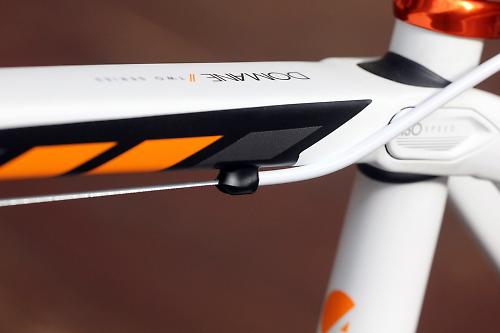
We reviewed last year’s £1,200 Domane 2.3 here on road.cc. We concluded that this aluminium model dampened high-frequency vibration pretty effectively, although not nearly as much as the higher-level carbon models.
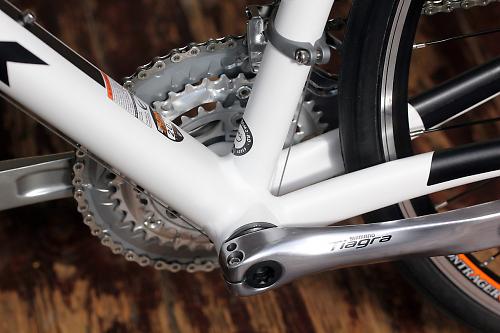
The design has been modified for 2014. You have to be careful when you flex aluminium because it can break. Previously, Trek welded two completely different aluminium tubes together to form the seat tube so that they could control the damping. You could see the weld an inch or two below the IsSpeed Decoupler.
Now, however, Trek have decided that they don’t need that weld. It is a single hydroformed tube that looks neater and, Trek say, is just as effective. It also shaves around 80g of weight from the previous version.

Trek call the Domane’s fork an IsoSpeed design too, although it doesn’t have a lot in common with the Decoupler. They reckon that the offset dropout at the end of the leg increases fore/aft compliance, absorbing road shock better than a conventional design rather than transmitting it straight up to your wrists.
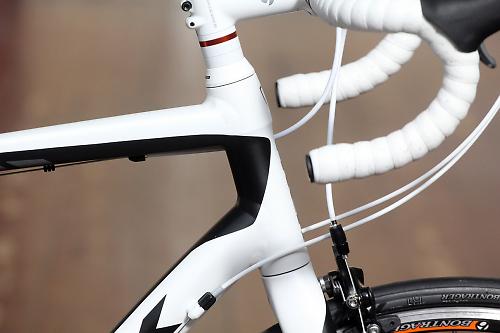
The Domane 2.0 is built to what Trek call an Endurance geometry which means that, like pretty much everyone else’s endurance geometries, it comes with a top tube that’s a touch shorter than that of a standard race bike, and a head tube that’s a touch longer.

We won’t go into too much detail here other than to say that the stack on our 56cm model is 59.1cm and the reach is 37.7cm. For comparison, Trek’s H2 fit on their Madone 2.0 has a stack of 57.7cm a reach of 38.7cm – so the Domane is a little shorter and higher for a more upright, more relaxed ride position. It’s still a racy setup, but not quite as aggressive as some, and your back might thank you for that.
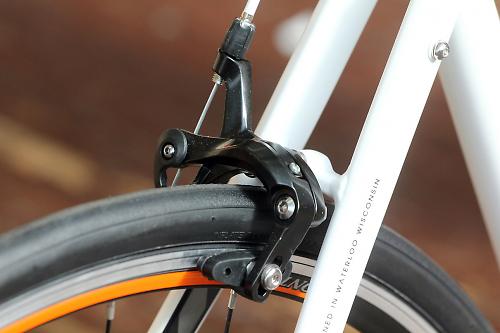
Another couple of frame characteristics worth mentioning are that the Domane has hidden eyelets for full mudguards and rack mounts too. Oh, and it’s Speedtrap compatible, which means that a computer sensor can sit within the fork leg to measure your speed and distance, rather than poking out and adding to the drag. It also keeps things looking neat and tidy.
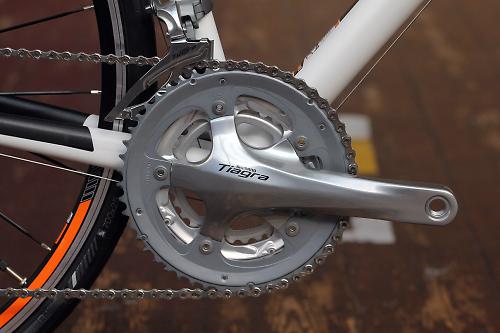
Trek offer two aluminium Domane’s: the Shimano 105-equipped 2.3 (£1,200) and this £1,000 2.0. As we said up top, the 2.0’s components are largely from Shimano’s 10-speed Tiagra range, the most notable component being the triple chainset with 50, 39 and 30-tooth chainrings matched up to a 12-30-tooth cassette. That combo gives you a super-low gear that should see you up pretty much any gradient you fancy without too much trouble. You’re not going to be incredibly fast in such a small gear, but at least you won’t have to get off and walk.
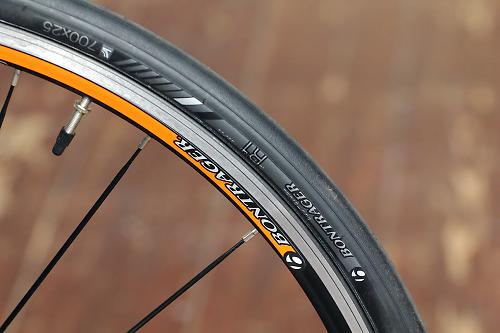
Most of the other components, including the brakes and wheels, are from Trek’s in-house Bontrager brand.
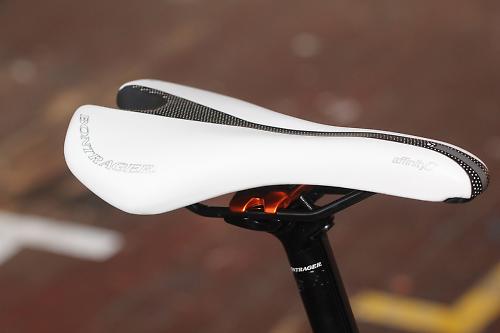
Right, that’s yer lot for now. We’re going to hit the road to find out how the Domane 2.0 rides. We’ll be back with a review on road.cc soon. In the meantime, find more details at www.trekbikes.com.
Mat has been in cycling media since 1996, on titles including BikeRadar, Total Bike, Total Mountain Bike, What Mountain Bike and Mountain Biking UK, and he has been editor of 220 Triathlon and Cycling Plus. Mat has been road.cc technical editor for over a decade, testing bikes, fettling the latest kit, and trying out the most up-to-the-minute clothing. He has won his category in Ironman UK 70.3 and finished on the podium in both marathons he has run. Mat is a Cambridge graduate who did a post-grad in magazine journalism, and he is a winner of the Cycling Media Award for Specialist Online Writer. Now over 50, he's riding road and gravel bikes most days for fun and fitness rather than training for competitions.
Latest Comments
- hawkinspeter 3 min 41 sec ago
Excellent - I think I'll replace my emergency tube that is a real squeeze to get into the little Topeak bottle cage bag thingy.
- don simon fbpe 7 min 41 sec ago
I'm genuinely shocked by his their reaction.
- arckuk 8 min 56 sec ago
I enjoyed this guy I captured with his hound on New Oxford Street a few years ago.
- chrisonabike 9 min 30 sec ago
That's perspective though - not a small number of americans would consider the current UK government "socialist"....
- Bungle_52 10 min 47 sec ago
I know this is a bit late but one thing that hasn't been mentioned yet is the extra wear and possible damage to the cycle lane surface due to being...
- Patrick9-32 54 min 45 sec ago
*bursts back into the room hours after the conversation has moved on*...
- notMyRealName 55 min ago
Damn, that sucks. I generally feel pretty relaxed with my bike on Avanti trains because the compartment is locked and I don't have to worry about...
- Muddy Ford 1 hour 27 min ago
They are ugly, and presumably require registration to use them. But the argument "it should be car parking instead" is absurd. Surely a camera and...
- LeadenSkies 1 hour 33 min ago
It's endemic now. Watched a skip lorry jump two reds within 100m on my commute this morning. No intention of stopping.
- cyclisto 1 hour 57 min ago
I strugle to think other as cool bikes as this. If my city was flatter and I fitter, I would drool over it....



































Add new comment
17 comments
Gotcha.
Wings falling off planes would be pretty bad for business, one would imagine.
That paint job is disgusting....what's going on? Last year's was nice!
Having built up several bikes with both, I prefer Tiagra over 105. Cable routing on 105 brifters is like Swiss watch repair. Tiagra is a snap to set up. I like the range of the triple, but might upgrade the RD (as little as £25) for the 5701 medium cage. Another nice thing (IMHO) about the Tiagra exposed shift cables is they look better on a "classic" build. And I swear they shift as well or better than 105s. Shame about the dorky gear indicators.
Hi to all of you eager beavers with loads of money and a very very short impulse buying fuse.
Is this the early stages of the introduction to 'Throw away Bikes'?
Yes,believe me I am aware that this kind of money is not throw away but in the real and easily convinced world of get it on tick;it is only bla bla per month and coupled with the modern day world of not questioning the 'Experts' and believing just about everything that goes into print or is published on the internet and further accelerated by a thumbs-up/like or Trending figures,this is just another marker.
At 68yrs young,I will probably be dead and incinerated by the time some of these get cast aside because of failures of the alleged benefits that was part of the 'Rush out now and get one' mentality and get left in sheds all over the world.
Look at some of the older steel frames that are still around and remain as perfectly functioning cycles,some of which have change hands many times and lovingly lavished with a refurbishment programme.
I very much doubt that the same will be experience by some of the current hyped up bikes.
I believe the many destined-for-obsolescence bottom bracket standards currently flooding the market are the true herald for disposable bicycles.
It's interesting that you chose to post these thoughts on a review of a fairly modest Trek (albeit £1k isn't insignificant). Seems to me like a lot of bike for the money and if it is half as good as my first road bike (also a Trek) there's many years and miles of use in it. There are plenty other bikes reviewed here that should be the focus of your ire. I'm thinking of 'gravel racers' in particular.
If the isocoupler thing is a way of engineering more comfort into a alu frame, then surely the comfort and lightness of this frame gives it greater longevity? Whilst steel is inherently more forgiving, its a heavier lump to haul over the hills. If this bike allows people to cycle for more years, then its a good thing.
As a rule my bikes last me 5-10 years of regular riding. Maybe you should avoid mobile phone websites if your issue is instant gratification?
I've had my Domane 2.0 for a year and love it. The IsSpeed Decoupler works really well and makes for a very smooth ride. It handles uneven surfaces really well and is the most comfortable bike I've ever ridden (& that includes my Specialized Roubaix Expert).
I use it for my daily commute and cycling in the lanes at the weekend when it's wet. It would be even better, though, if it had disc brakes...
I know they probably put thought into the issue, but is it really that smart to use a bike design based on the flexibility and fatiguelessness of carbon on a material that isn't?
How long can you ride the frame until the aluminium fatigues and gives up?
I wouldn't be too sure about the 'fatiguelessness' of carbon! My girlfriend has just written an entire PhD on the fatigue modelling of carbon composites. They do fatigue, its just no where near as well understood as fatigue mechanisms in metals. Obviously this is of great interest to the aerospace industry.
I'd be interested in seeing some of her research.
I'd be really interested in hearing more about this if possible? Then again, I daresay various companies would pay her rather a lot to keep it discreet - F1, aerospace etc. Sounds like she'll be onto a good living in return for all that effort - good luck to her.
Why would you assume some sort of industrial conspiracy? This type of research is valuable in improving the quality of the product - not to uncover flaws being hidden by corrupt corporations. People have been researching the properties of steel for decades, it's not getting paid off and swept under the carpet by those building skyscrapers.
Oh, no conspiracy to cover up failures, just plain old competition at the cutting edge. Years ago, I used to work with a guy whose son did some sort of student placement with an F1 team. While there, he came up with an innovation that could detect in real time whether the carbon being weaved was at the correct angle (that was how he described it - no doubt it was rather more nuanced/niche than that). Previously they could only inspect it after production, which was driving the cost up due to the number of failures. As a result, they took him on full-time, but the new development was kept close to their chests. The reduction in time/effort, and the ability to divert the money to other things represented a competitive advantage for them.
I don't know about a conspiracy! It is moderately well discussed in the academic literature, eg.:
http://dx.doi.org/10.1016/j.ijsolstr.2004.02.040
At the moment, particularly in aerospace, composite structures are massively over-engineered, because the fatigue property of composites are still being understood. My understanding is that there is still a lot of potential for lighter parts, just that (understandable) conservatism is holding things back.
I think 200 more for the 105 version would be money well spent
True but it wouldn't hit the magic Cycle To Work price point then. Nice bikes, had my 2.0 for about 16 months now and the rear end ride really is something rather special - rest of it is pretty good, but i'd say the IsoSpeed is the real difference.